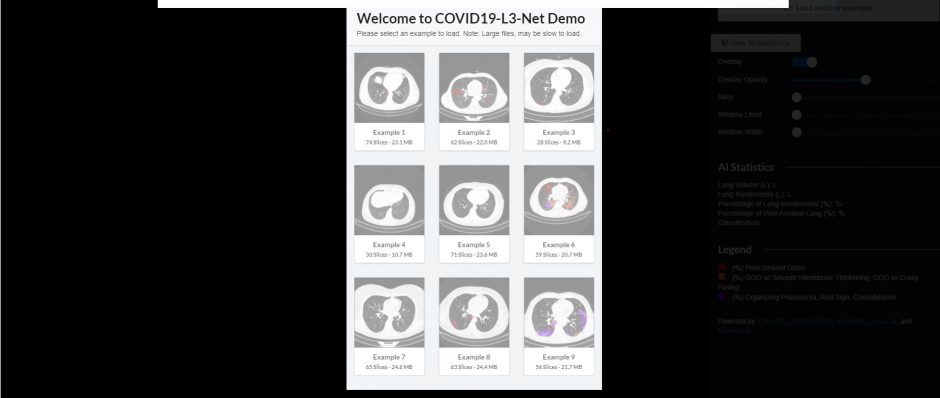Demo – Version 1
Project phases
- Phase 1 - Open Source AI Model for COVID-19 CT Diagnostics and Prognosis
- Phase 2 - Demo – Version 1 (current page)
- Phase 3 - Application - Version 2
- Phase 4 - L3-Net Version 3.0
This demo displays the predictions from our 2D UNet model on a random sampling of our test set after they have been processed using an automatically generated mask. This mask is calculated by finding the two largest connected components in the predictions for the entire scan, which correspond to the right.
Important notes
This is not for medical or diagnostic use. This is for Research and Demo use only. No health regulatory approval has been received. Demo scans are reprocessed upon release of new model architecture or updated weights from our github page. Results may vary as a result, but we are committed to continual improvement.
Clinical Utility
The percentage of lung involvement is a valuable metric that is difficult to accurately measure without advanced software tools, such as Artificial Intelligence. We hope that utilizing a machine to accurately calculate the lung involvement ratio and absolute volume will be a valuable metric for researchers to use to prognosticate patients with COVID-19 and other respiratory illnesses. Recent literature suggests that the percentage of Well-Aerated-Lung correlates to clinical outcomes, such as the need for ventilator support, ICU admission and death.
L3-Net also segments important regions of opacity seen in patients infected with COVID-19, including Pure Ground Glass, Crazy Paving, and Consolidation. We hope these metrics will help researchers better assess patients with COVID-19 and potentially could help to prognosticate these patients into appropriate clinical outcome categories.
This model is our gift to the research community to support future research in this space. Thanks for visiting.
About the University of British Columbia Cloud Innovation Centre (UBC CIC)
UBC’s CIC is a public-private collaboration between UBC and Amazon. A CIC identifies digital transformation challenges, the problems or opportunities that matter to the community, and provides subject matter expertise and CIC leadership.
Using Amazon’s innovation methodology, dedicated UBC and Amazon CIC staff will work with students, staff and faculty, as well as community, government or not-for-profit organizations to define challenges, to engage with subject matter experts, to identify a solution, and to build a Proof of Concept (PoC). Through co-op and work-integrated learning, students also have an opportunity to learn new skills which they will later be able to apply in the workforce.
UBC’s CIC focuses on Community Health and Wellbeing.

